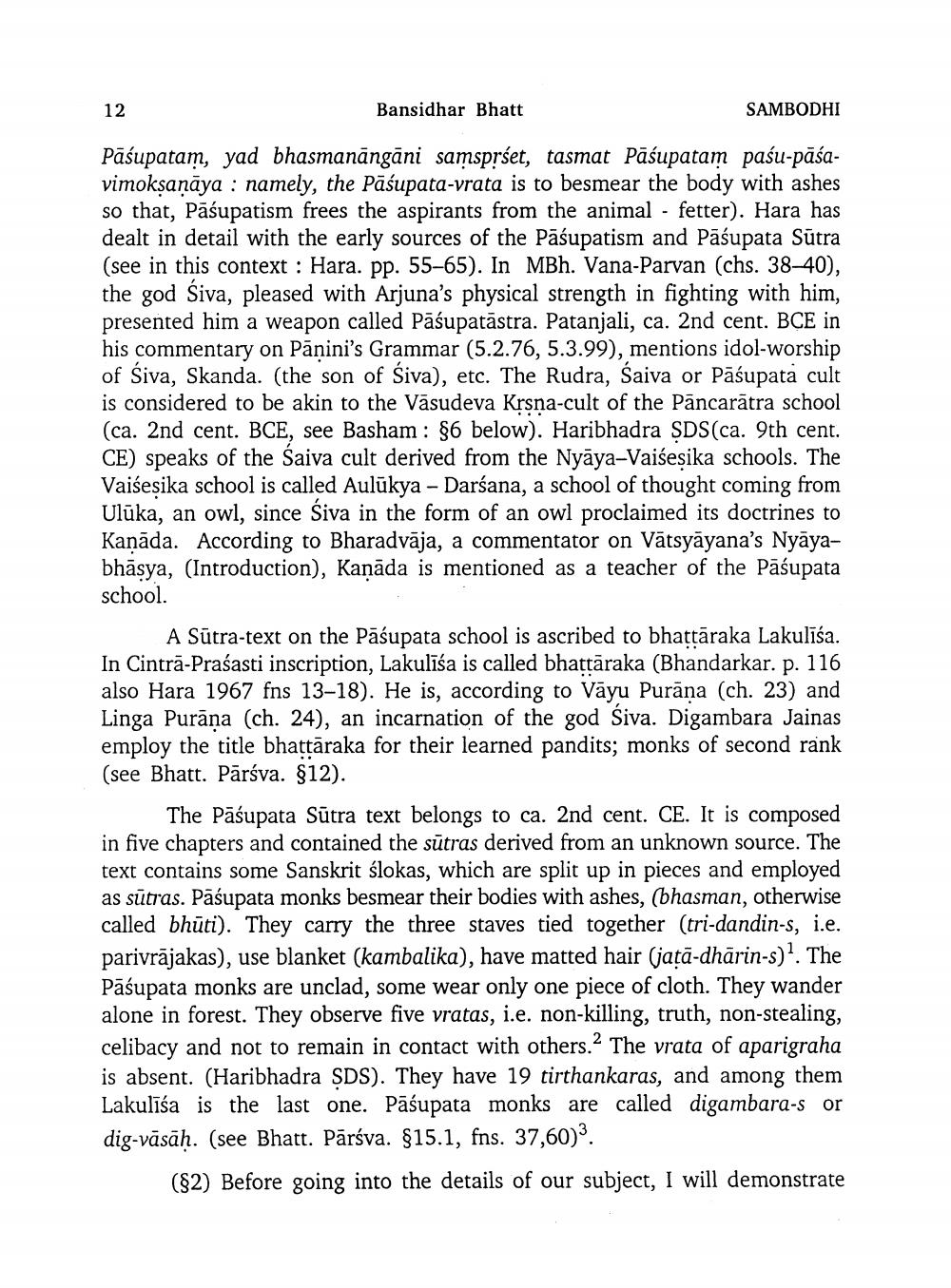________________
12
Bansidhar Bhatt
SAMBODHI
Pasupatam, yad bhasmanāngāni samspṛśet, tasmat Pasupatam pasu-pāśavimokṣaṇāya: namely, the Pasupata-vrata is to besmear the body with ashes so that, Pasupatism frees the aspirants from the animal fetter). Hara has dealt in detail with the early sources of the Pasupatism and Pāśupata Sūtra (see in this context: Hara. pp. 55-65). In MBh. Vana-Parvan (chs. 38-40), the god Śiva, pleased with Arjuna's physical strength in fighting with him, presented him a weapon called Pasupatastra. Patanjali, ca. 2nd cent. BCE in his commentary on Panini's Grammar (5.2.76, 5.3.99), mentions idol-worship of Śiva, Skanda. (the son of Śiva), etc. The Rudra, Śaiva or Pasupata cult is considered to be akin to the Vasudeva Kṛṣṇa-cult of the Pancarātra school (ca. 2nd cent. BCE, see Basham: §6 below). Haribhadra SDS (ca. 9th cent. CE) speaks of the Saiva cult derived from the Nyāya-Vaiśeṣika schools. The Vaiśesika school is called Aulukya - Darśana, a school of thought coming from Ulūka, an owl, since Śiva in the form of an owl proclaimed its doctrines to Kanāda. According to Bharadvaja, a commentator on Vätsyāyana's Nyāyabhāṣya, (Introduction), Kanāda is mentioned as a teacher of the Pasupata school.
A Sūtra-text on the Pasupata school is ascribed to bhaṭṭāraka Lakulića. In Cintra-Prasasti inscription, Lakulīśa is called bhaṭṭāraka (Bhandarkar. p. 116 also Hara 1967 fns 13-18). He is, according to Vayu Purāṇa (ch. 23) and Linga Purana (ch. 24), an incarnation of the god Siva. Digambara Jainas employ the title bhattaraka for their learned pandits; monks of second rank (see Bhatt. Pārśva. §12).
The Pasupata Sutra text belongs to ca. 2nd cent. CE. It is composed in five chapters and contained the sutras derived from an unknown source. The text contains some Sanskrit slokas, which are split up in pieces and employed as sūtras. Pāśupata monks besmear their bodies with ashes, (bhasman, otherwise called bhūti). They carry the three staves tied together (tri-dandin-s, i.e. parivrājakas), use blanket (kambalika), have matted hair (jaṭā-dhārin-s)1. The Pasupata monks are unclad, some wear only one piece of cloth. They wander alone in forest. They observe five vratas, i.e. non-killing, truth, non-stealing, celibacy and not to remain in contact with others.2 The vrata of aparigraha is absent. (Haribhadra SDS). They have 19 tirthankaras, and among them Lakulīśa is the last one. Pasupata monks are called digambara-s or dig-väsäḥ. (see Bhatt. Pārśva. §15.1, fns. 37,60)3.
(§2) Before going into the details of our subject, I will demonstrate




